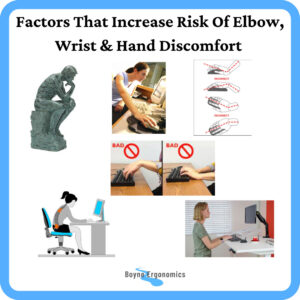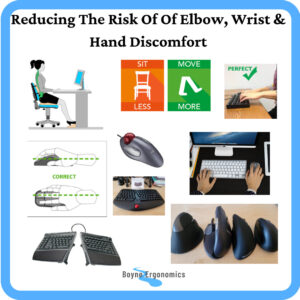Over the last year of carrying out virtual home worker DSE assessments, I have seen a marked increase in the number of employees reporting tightness, discomfort and pain in the shoulders, elbows, forearms, wrists and hands, compared with pre-Covid office-based assessments.
It would be fair to surmise that this increase is likely due to lack of suitable equipment, inappropriate workstation set up, adverse postures and increased DSE workload among home-workers. Even if the initial injury was not DSE related, poor conditions can act to aggravate any underlying injuries or issues.

But what can be done to reduce discomfort in the upper limbs when at the DSE workstation?
Address Your Posture and Support
Make sure you are seated at the correct height for your work surface and that your work surface is at the correct height for you if you are using a standing workstation.
Your elbows should be level with the top of your work surface, or keyboard keys if using a thick profile mechanical / ergonomic keyboard, when your shoulders are relaxed and arms by your sides. This will encourage a horizontal forearm posture and reduce strain on your shoulders. Use additional support underfoot if your feet cannot be planted on the floor when your elbows are in the correct position.
If your work surface is too shallow (<10cm between edge of the keyboard and the edge of the desk) consider adding additional support. This can be done using a chair with adjustable armrests or with a desk extender. If your chair has adjustable armrests, once you have adjusted your seated height to the appropriate position, adjust the height of the armrests so they sit just under your elbow. This should give additional support without raising your shoulders. If possible, adjust the depth so they do not impede your access to the desk and adjust the width / rotation so they are not too far from your body. If your armrests cannot be appropriately adjusted, a desk extender can be added to the front of your desk to provide additional depth and support.
Address Your Inputting Devices
The keyboard and mouse shoulder be close enough to you that you can use them, with shoulders relaxed and arms by your side, when you are seated back against your backrest. If the wires restrict their positioning, check to see if you can get some slack on the wires. If not, consider wireless devices. Keep an eye on your mouse position, it should be next to the keyboard and not off to the side. Ensure the devices are working correctly.
If you are using a mousepad with a wrist rest, or a gel/foam pad in front of the keyboard, make sure to rest your palms on them and not the wrist. Resting the wrist on these pads encourages adverse and repetitive movement of the wrists and hands when typing and using the mouse. Wrist rests on mouse pads can also reduce blood flow to the mouse hand.
There are keyboards and mice available that are designed to reduce the adverse forearm, wrist and hand postures associated with standard horizontal devices.
Ergonomic keyboards and mice are designed to keep the forearms, wrists and hands in a more natural position, reducing strain on the tissues. There are many designs available and suitability depends on how you use the devices and the underlying issue.
A vertical mouse would be a good place to start if you are experiencing discomfort in your mouse arm or wrist. They can help reduce strain by reducing forearm pronation by keeping the hand in the natural handshake position.
If you are right-handed and experience discomfort on the right side look at improving right upper limb posture and reducing the workload on this side. An ambidextrous mouse is a good option so you can try and use the mouse with your non-dominant hand.
Aim to reduce the reach distance to the mouse. If you do not use the numberpad on the keyboard, change the keyboard to a mini or compact keyboard to allow the mouse to be positioned closer the the body. If you do use the numberpad on the keyboard, consider changing to a compact keyboard with a retractable numberpad, or better still, a left-handed keyboard. This will improve shoulder posture and reduce the workload on the right upper-limb.
If you are experiencing discomfort in both arms and hands, an adjustable split keyboard can be used to improve your upper limb posture when typing.
Address Your Use of the Inputting Devices
Another way to reduce the risk of upper limb discomfort and strain, is to reduce the amount of time spent at the desk using the devices. Working from home has increased our DSE use as we can no longer get up from the desk to ask a colleague a question or run something by your manager. Most of these interactions are done over email or internal messaging, increasing the workload on the upper limbs.
Do not grip the mouse when using it. Rest the hand gently on it and use whole arm movements when operating the mouse to reduce repetitive strain on the wrists. When typing, glide the hands over the keyboard as opposed to dropping the wrists and deviating the hands when typing.
If you are not using the mouse or keyboard, do not rest your hands on them. Stretch your hands and wrists regularly. Aim to spend no more than 45 minutes continuously at the DSE workstation before getting up and moving around for at least 30 seconds to give the muscles in the upper limbs a chance to relax.
Another option is to reduce the amount of mouse and keyboard interaction required by using speech to text software such as Dragon Professional, Microsoft Azure, Speechmatics, Watson Speech to Text etc. There is also Google GBoard and Microsoft Windows 10 Speech Recognition available. These software options can take time to set up and get used to but they greatly reduce the need for typing and mouse use and should be considered if there is an underlying medical condition that is being aggravated by DSE use.

Seek Professional Help
Finally, every role is different, every task is different and every person is different. If you are experiencing discomfort when using the keyboard and mouse that is not eased by postural adjustments, I recommend that you undergo an ergonomic assessment to identify potential issues and advise on the most appropriate solution for you.


